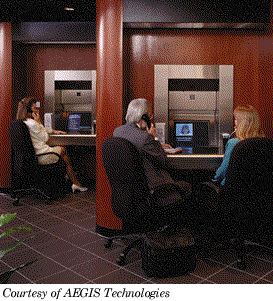 During
the last quarter century, banking has undergone a revolution. Technology has transformed
the way Americans obtain financial services. Telephone banking, debit and credit cards,
and automatic teller machines are commonplace, and electronic money and banking are
evolving. The techniques of bank examination have changed, too. Today OCC examiners use
computers and technology to help ensure that the banks they supervise understand and
control the risks of the complex new world of financial services. During
the last quarter century, banking has undergone a revolution. Technology has transformed
the way Americans obtain financial services. Telephone banking, debit and credit cards,
and automatic teller machines are commonplace, and electronic money and banking are
evolving. The techniques of bank examination have changed, too. Today OCC examiners use
computers and technology to help ensure that the banks they supervise understand and
control the risks of the complex new world of financial services.  The OCC supervises national banks and enforces federal banking laws. It rules on new
charter and merger applications for national banks, and conducts basic research on banking
and the economy. The tools have changed, but for the OCC, the basic mission remains the
same as in the days of Lincoln: to ensure a safe, sound, and competitive national banking
system that supports the citizens, communities, and economy of the United States.
The OCC supervises national banks and enforces federal banking laws. It rules on new
charter and merger applications for national banks, and conducts basic research on banking
and the economy. The tools have changed, but for the OCC, the basic mission remains the
same as in the days of Lincoln: to ensure a safe, sound, and competitive national banking
system that supports the citizens, communities, and economy of the United States.
Banking units like these interactive video systems -- which can
be placed in a shopping mall, supermarket or banking branch lobby -- connect bank
customers to bank product specialists who can execute transactions from a central office.
More of the Changing World of Banking:
 Introduction Introduction 1790 to 1832 1790 to 1832  1832 to 1864 1832 to 1864
 1865 to 1914 1865 to 1914 1929 to 1970 1929 to 1970 1970 to
Today 1970 to
Today
|



 The OCC supervises national banks and enforces federal banking laws. It rules on new
charter and merger applications for national banks, and conducts basic research on banking
and the economy. The tools have changed, but for the OCC, the basic mission remains the
same as in the days of Lincoln: to ensure a safe, sound, and competitive national banking
system that supports the citizens, communities, and economy of the United States.
The OCC supervises national banks and enforces federal banking laws. It rules on new
charter and merger applications for national banks, and conducts basic research on banking
and the economy. The tools have changed, but for the OCC, the basic mission remains the
same as in the days of Lincoln: to ensure a safe, sound, and competitive national banking
system that supports the citizens, communities, and economy of the United States.